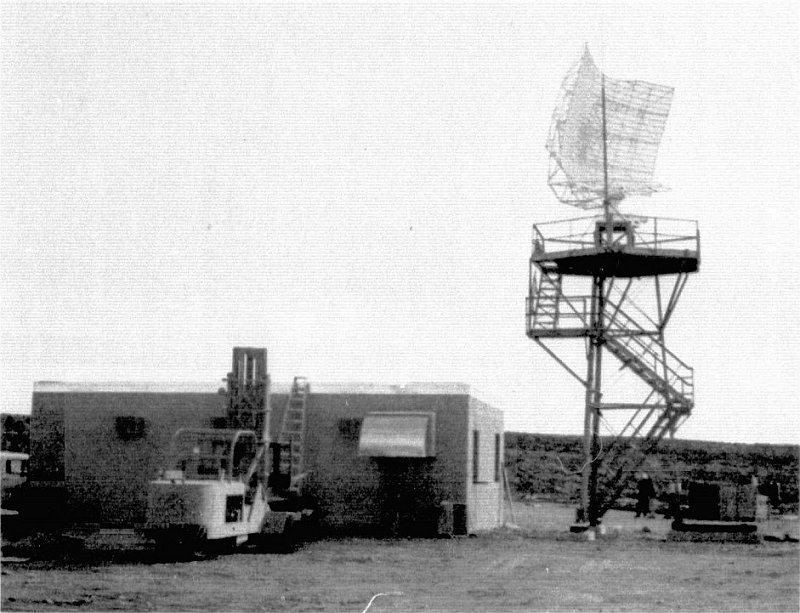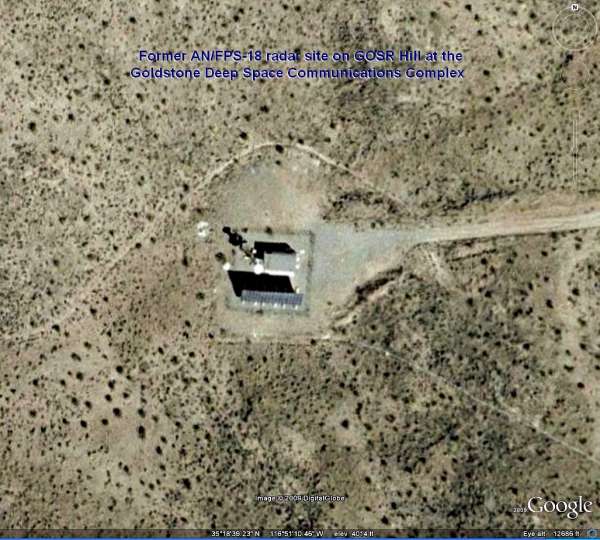 AN/FPS-18 Radar at the Goldstone Deep Space Communications Complex. Source: http://ntrs.nasa.gov/archive/nasa/casi.ntrs.nasa.gov/19770005301.pdf
AN/FPS-18 Radar at the Goldstone Deep Space Communications Complex. Source: http://ntrs.nasa.gov/archive/nasa/casi.ntrs.nasa.gov/19770005301.pdfThe AN/FPS-18 radar system at the former Engelhard Gap-Filler Annex, NC, sat in place, inoperative, from site deactivation in April 1968 until some time in 1975. All equipment, including the radar tower and the antenna, remained in place.
It was a complete radar system including the drive motor and diesel generators. It had been purchased by Radio Research Instrument Co., Inc., in Waterbury, CT, which bought it at auction. Bendix Field Engineering Corporation (BFEC) subsequently paid an estimated $30,000 for the system as was.
There was significant corrosion on the equipment when it was removed. The red aircraft-warning light on top of the antenna still was still operating, though, and had been serving as a navigational aid for the local fishing fleet.
After restoration in Columbia, MD, BFEC did a complete set up of the system at their test site, and ran a full operational test. The biggest problem was a constant change of voltage and receiver outputs; the problem was that all the capacitors in the receivers and performance monitor were bad, and had to be changed.
In late 1976, this AN/FPS-18 radar set was installed at the Goldstone Deep Space Communications Complex (GDSCC) in California. The radar became part of the "Goldstone Operational Support Radar� (GOSR) system. The location became known as GOSR Hill. The GOSR Hill radar site was located at Latitude 35� 18' 39" N, Longitude 116� 51' 11" W.
The purpose of the GOSR radar was to monitor commercial and private air traffic between the greater Los Angeles area and Las Vegas. In the 1980s, NASA was experimenting with high-power laser transmissions to aircraft and satellites. Although Goldstone was a restricted flight zone, often private pilots would shortcut through the zone. The radar was there to monitor intrusions and then to shut down the laser transmissions until the zone was clear.
The system had two significant drawbacks: 1) it required a dedicated set of eyes on the radar scope, and 2) none of the Supervisors on Duty (SODs) or Radar Operators were trained in reading the scopes in order to distinguish a target from ground clutter. GDSCC later transitioned to an airspace coordination method through the Goldstone Frequency & Airspace Coordination (GFAC) office that is still in place today.
The AN/FPS-18 radar itself is no longer there. Today, the building at the GOSR site houses microwave-relay equipment for China Lake NWC, installed circa 2001. In the aerial image from �Google Earth,� one can also see the solar panels that the Navy installed.
Compiled from e-mail notes between Tom Page and Dennis Schehl, Don Hill, Ralph McConahy, and Reid Drummond.
 AN/FPS-18 Radar at the Goldstone Deep Space Communications Complex. Source: http://ntrs.nasa.gov/archive/nasa/casi.ntrs.nasa.gov/19770005301.pdf
AN/FPS-18 Radar at the Goldstone Deep Space Communications Complex. Source: http://ntrs.nasa.gov/archive/nasa/casi.ntrs.nasa.gov/19770005301.pdf



